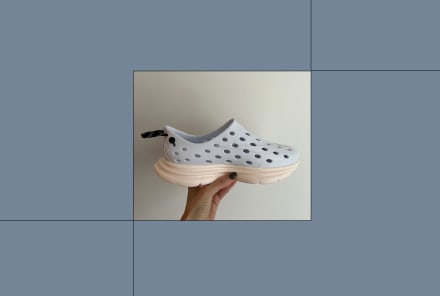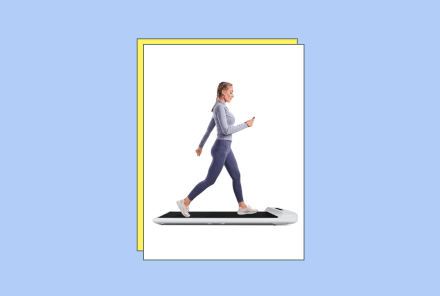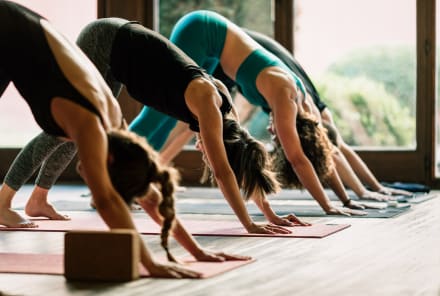Advertisement
Feeling Anxious? This Yoga Sequence May Help

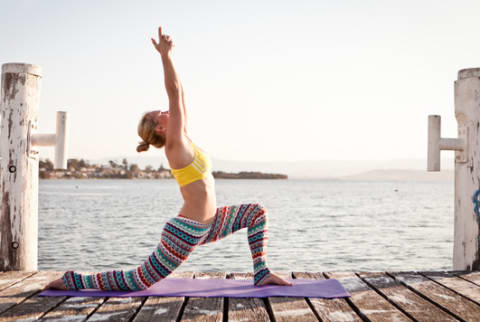
Anxiety, at its root, can be identified as raw sensations in the body. When we apply the practice of restorative yoga to anxiety, we can begin the practice of observing those raw sensations and then toning our own nervous systems. Over time, we "build the muscle" of being able to choose when it's time to consciously plan ahead and address concerns in our lives and when it's time to surrender to life's inevitable unknowns.
Most of us need a little practice in the letting-go part. On a physiological level, restorative yoga (depending on the posture, of course) teaches us to relax the facial muscles, release the chest muscles, and soften the belly. We learn to relax the fingers and toes and soften the brain. On an emotional level, restorative yoga teaches us to strengthen our muscles of surrender, observance, and acceptance. In restorative yoga, we use the body to heal the mind.
If you're feeling anxious, give restorative yoga a try: start with these four poses
Supta Baddha Konasana (supported bound angle pose)
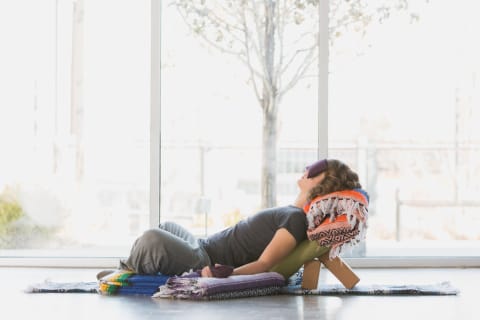
A classic and often favorite among restorative yoga practitioners, this posture is excellent for creating space in the abdomen and hips. Similar to supported bridge, heart openers generally encourage a deeper breath, which can promote emotional balance by lifting the spirits—particularly for those under a lot of anxiety or stress.
Place a bolster on top of two stable and strong blocks, designed to bear the weight of the body (see picture). Place a folded blanket on the top of the bolster and two blankets (folded lengthwise) on the floor to support the arms. Roll two blankets to support the outer thighs. Sit close to the bolster so that the sacrum is touching the edge of it, and place the feet together and allow the knees to fall apart. Firmly tuck the blankets into the outer thighs so the legs feel fully supported. Lie back on the bolster and adjust the blanket under the head so that the chin rests slightly below the forehead. Rest the forearms and hands on the blankets, palms facing up. Relax your face. Breathe naturally.
Props needed: 1 bolster, 2 blocks, 5 blankets
Recommended time: 5-10 minutes
Viparita Karani (legs up the wall pose)
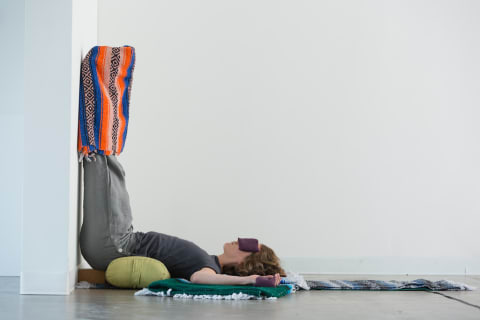
Those who suffer from anxiety or panic attacks can suffer from a dysregulated parasympathetic nervous system. In other words, when you want to rest, you simply can't.
This restorative inversion is a great way to relieve tired and swollen legs and feet in addition to providing a potentially restorative effect on balancing the autonomic nervous system. When the nervous system is balanced, one can perform with focus and ease under stressful conditions but is also capable of rest when the time for restoration is needed.
Place a block in the center of your mat, pressed firmly against the wall. Then, place the bolster sideways, pressed firmly up to the block. Sit on the floor, to either side of the bolster, with your knees facing away from it and your lower back pressed up against its edge. Lie down on the floor, allowing your hips to come onto the bolster and your legs to extend gently up the wall. Reach the heels up the wall and allow the outer edges of your feet to move toward the floor. Relax the feet. Bend the arms with the palms facing up to open the chest.
Props: 1 bolster, 2 blocks, 3 blankets
Recommended time: 4-6 minutes on each side
Supported Balasana (child's pose)
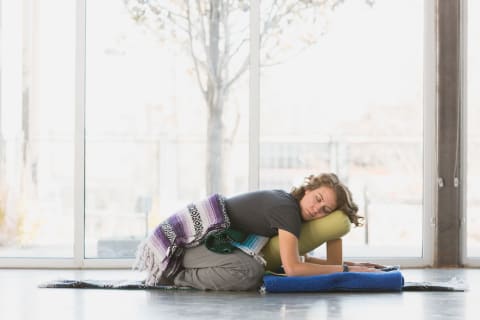
This supported variation of child's pose allows for a deep hip-opening, a lengthening of the lower back, and release of the shoulders. Energetically, forward bends can help alleviate anxiety by encouraging the mind to turn inward and reduce external stimulation from other people and environments.
Place the bolster lengthwise on your mat, with two blocks supporting the far end of the bolster. Sit facing the bolster with your toes together and your knees apart. Rest the hips toward the heels and lie on top of the bolster, ensuring your spine lengthens as you lower. Rest your arms and hands on blankets (folded lengthwise) to support the entire length of the arms. For additional lower back opening, roll a blanket and tuck it into the belly (the space between the ribs and the pelvis) before you lie over the bolster.
Props needed: 1 bolster, 2 blocks, 2 blankets
Recommended time: 3-5 minutes
Side-Lying Savasana
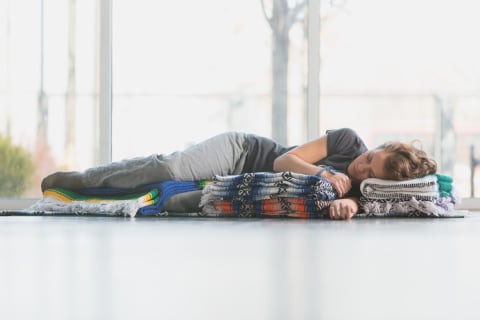
Anxiety related to certain traumas, such as an assault of any kind, can leave yoga practitioners feeling unsafe to lie on the back in classic savasana. For these practitioners, the front body feels vulnerable and exposed, thus causing this posture to elicit more anxiety than restoration. This restorative version of the classic corpse pose can feel more restful and safe for some, given that the practitioner can hold onto a bolster or blankets to protect the front body and also be closer to exiting the pose if necessary.
Lie on your left side. Stack blankets underneath the head so that the head is in line with the spine (chin is slightly tucked in). Stack blankets to support the right arm and hand. Place a blanket between the legs. Rest completely. Breathe naturally.
Props: 3-5 blankets
Recommended time: 15 minutes
Watch Next
Enjoy some of our favorite clips from classes
Enjoy some of our favorite clips from classes
What Is Meditation?
Mindfulness/Spirituality | Light Watkins
Box Breathing
Mindfulness/Spirituality | Gwen Dittmar
What Breathwork Can Address
Mindfulness/Spirituality | Gwen Dittmar
The 8 Limbs of Yoga - What is Asana?
Yoga | Caley Alyssa
Two Standing Postures to Open Up Tight Hips
Yoga | Caley Alyssa
How Plants Can Optimize Athletic Performance
Nutrition | Rich Roll
What to Eat Before a Workout
Nutrition | Rich Roll
How Ayurveda Helps Us Navigate Modern Life
Nutrition | Sahara Rose
Messages About Love & Relationships
Love & Relationships | Esther Perel
Love Languages
Love & Relationships | Esther Perel



